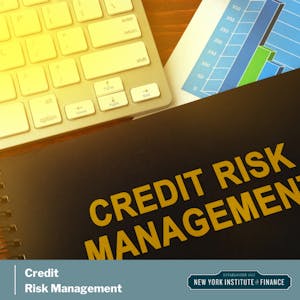Credit Risk Management Frameworks and Strategies
In this course, you will use business and industry analysis to understand companies, projects, business models, and financing proposals. You will then prepare qualitative risk analysis for specific companies to use as the basis for financial analysis, project analysis, and risk decisions. Lastly, you will understand how to use financial ratios and financial metrics to evaluate a company or project’s profitability, balance sheet, capital structure, and cash flow to assess overall financial performance and risk profile.
Use business and industry analysis to understand companies, projects, business models, and financing proposals
Prepare a qualitative risk analysis for specific companies to use as the basis for financial analysis, project analysis, and risk decisions
Understand the principles & concepts of credit risk including categories of risk, types of exposure, credit products, expected/unexpected credit loss
Syllabus
Syllabus - What you will learn from this course
Week 1
Getting Started
Week 2
Module 1: Principles and Concepts
This course will introduce you to the credit risk management principles and concepts. You will also learn about default trends, market indicators and Portfolio Management.
Week 3
Module 2: Default Trends and Market Indicators
In this module, we’ll cover the principles and concepts of Credit Risk Management. We’ll review the purpose, benefits and analytical approaches to credit analysis and explore the integrated financial story, conclusions, and risk decision-making. We’ll also cover corporate balance sheets and analyze credit exposures. We’ll look at credit risk outlook and strategy, expected loss, risks and rewards and finally wrap up with a look at debt investors and debt and funding products.
Week 4
Module 3: Credit Portfolio Management
In this module, we’ll cover credit markets – trends and recent activity. We’ll look at credit spreads, default rates, default frequencies and default probabilities. We’ll also look at market indicators, bond spreads cred-t-default-swap markets and credit models. We’ll wrap up this module with a look at credit markets and analysis during the pandemic, defaults and bankruptcies.
Week 5
End of Course
FAQ
When will I have access to the lectures and assignments?
Access to lectures and assignments depends on your type of enrollment. If you take a course in audit mode, you will be able to see most course materials for free. To access graded assignments and to earn a Certificate, you will need to purchase the Certificate experience, during or after your audit. If you don't see the audit option:
The course may not offer an audit option. You can try a Free Trial instead, or apply for Financial Aid.
The course may offer 'Full Course, No Certificate' instead. This option lets you see all course materials, submit required assessments, and get a final grade. This also means that you will not be able to purchase a Certificate experience.
What will I get if I subscribe to this Specialization?
When you enroll in the course, you get access to all of the courses in the Specialization, and you earn a certificate when you complete the work. Your electronic Certificate will be added to your Accomplishments page - from there, you can print your Certificate or add it to your LinkedIn profile. If you only want to read and view the course content, you can audit the course for free.
Is financial aid available?
Yes. In select learning programs, you can apply for financial aid or a scholarship if you can’t afford the enrollment fee. If fin aid or scholarship is available for your learning program selection, you’ll find a link to apply on the description page.
Reviews
I learnt alot in this course and will rate it 100%
Sneak peek into Credit Risk Management, you will get an idea of usual terms that you see your colleagues are using.
Such a great course. It provided me several concepts in credit risk and risk mitigation.
